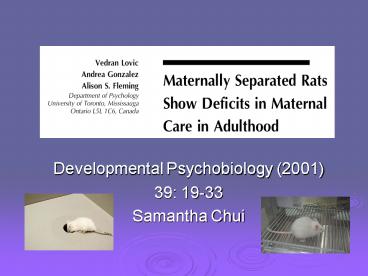Developmental Psychobiology 2001 - PowerPoint PPT Presentation
1 / 24
Title:
Developmental Psychobiology 2001
Description:
Amount of licking received from the mother is positively correlated with the ... Less time pup-body licking and crouching over pups as adults ... – PowerPoint PPT presentation
Number of Views:83
Avg rating:3.0/5.0
Title: Developmental Psychobiology 2001
1
- Developmental Psychobiology (2001)
- 39 19-33
- Samantha Chui
2
QUESTION
- What deficits do maternally separated rats show
in juvenile and adult maternal behaviour?
3
Hormones
- Maternal behaviour is initially under the control
of hormones associated with the end of pregnancy
and parturition (decreases with time after
parturition) - Maternal behaviours can include
- Pup body licking
- Pup retrieval
- Nursing
4
Virgin Rats
- Initially avoidant towards foster pups
- If continually exposed (SENSITIZATION), will show
full repertoire of maternal behaviours - Juvenile rats (18-30 days old) also show maternal
behaviour when exposed to foster pups - THEREFORE Neither steroid nor pituitary hormones
are necessary for the display of maternal
behaviour.
5
Early Life Experiences- Early life attention -
- Amount of licking received from the mother is
positively correlated with the amount of licking
these offspring (as adults) show toward their
newborns
6
- Early life separation -
- Brief separation is beneficial, NOT because of
absence of maternal attention, but rather by the
increase in attention given when the pups are
reunited with their mother - Prolonged periods of separation are often
accompanied by nutritional loss, body temperature
loss and less overall licking
7
Purpose
- To assess whether early-life maternal separations
disrupt the display of adult maternal behaviour - To assess whether early-life separation from
mother disrupt the display of juvenile maternal
behaviour
8
General Procedure
- Rat female pups were either separated (SEP) from
their mothers for 5 hr daily from 1 to 17 days of
age or left with their mothers (NSEP) - As juveniles received either contact with pups
(P), with a same aged con-specific (S), or no
social cues (I) for 5 consecutive days - In adult hood, animals were assessed for their
maternal behaviour after the birth of their
litters
9
Procedure
- 1. Neonatal experimental manipulations (between
Day 1-17) - Each litter culled to 6 female, 6 male
- Within the 6 females
- SEP 3 pups to undergo the separation procedure,
5 hours per day - NSEP 3 pups non-separated
- Tested on an elevated plus-maze on Day 21
10
Elevated plus maze
11
- 2. Juvenile experimental manipulations (between
Day 22-27) - 1 pup from NSEP and SEP in each litter were
randomly assigned to 1 of 3 conditions - I isolation from all other pups
- S having a same-age playmate
- P daily exposure to 1-4 day old pups pups left
with subject overnight and replaced with freshly
fed pups for the test the next day - Tested on the elevated plus maze then housed in
pairs
12
- 3. Adult experimental manipulations (Day 70 and
up) - Mated between Day 70 to 100
- At time of parturition, pups were removed within
15 min of each birth to prevent mothers from
having maternal experience - Assessed for maternal behaviour on 5 consecutive
days FOUR days after birth (to prevent early life
manipulations from being masked by parturitional
hormones)
13
Juvenile Maternal Behaviour
- Assess for maternal performance toward foster
pups over the 5-day period - Maternal behaviours consisted of
- Retrieval of pups
- Licking of pup bodies
- Licking the anogenital region of the pups
- Crouching
- Nest building
14
- Pup Body Licking -
- SEP juveniles spend less time licking pups than
NSEP juveniles, F(1,15) 4.964, p
15
- Nest Building -
- SEP juveniles spend less time nest building than
NSEP juveniles F(1, 15) 5.87, p - Other behaviours showed no separation effect but
did show significant increases
16
Adult Maternal Behaviour
- Assessed for maternal behaviour toward foster
pups 4 days after parturition - Maternal behaviours consisted of
- Retrieval of pups
- Licking of pup bodies
- Licking the anogenital region of the pups
- Crouching
- Nest building
17
- Pup body licking -
- Significant effects of separation on pup body
licking F(1, 41) 4.167, p - NSEP subjects spent more time engaging in this
behaviour
18
- Crouching over pups -
- Significant effects of separation on crouching
over pups F(1, 41) 77.976, p - NSEP subjects spent more time engaging in this
behaviour
19
NSEP Isolates
- NSEP isolates performed at about the same level
as the three groups of SEP animals - SEP isolates did not show reduced maternal
behaviour - Pups were isolated for only 5 days
20
Emotionality
- NSEP isolated group spent significantly less time
in the open arms than did either of the other
NSEP groups or any of the SEP groups
21
- If animals that have already experience
separation during early prewearning period, an
addition separation during juvenile period is
less deleterious
22
REMINDER
What deficits do maternally separated rats show
in juvenile and adult maternal behaviour?
23
ANSWER
- Maternally separated rats (SEP) spend
- Less time pup-body licking and nest-building as
juveniles (although these results were minimal) - Less time pup-body licking and crouching over
pups as adults - Isolated juveniles show deficits in adult
maternal behaviour when compared to non-isolated
juveniles
24
Thank You!






























